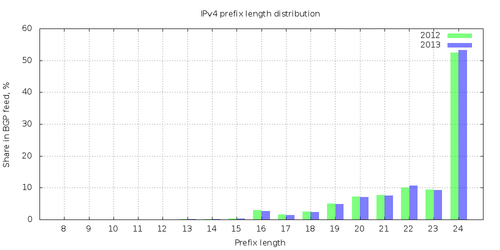IPv4 and IPv6 address space fragmentation
A while ago I’ve been discussing the IPv6 routing table growth issues with someone and realized I don’t really know how fragmented is it now. So I decided to find out.
I could find a dump from Nov 2012 from AS5612 edge, so it was possible to see what happened to the prefix length distribution in a year.
IPv4

Original high resolution image.
As expected, over 50% of the advertised prefixes are /24’s. The number of /22’s increased slightly, probably because it’s now default size for new allocations. The number of larger subnets decreased. We probably can say fragmentation of existing networks prevails over growth caused by new allocations.
IPv6

IPv6 picture is more interesting: /32 to /48 ratio reversed in a year. Simple analysis shows that most of new networks in the IPv6 table are new allocations rather than fragments of existing ones (roughly two times more new allocations than fragments). Lots of new /48’s are provider independent allocations. So even though the number of smaller networks increases, breaking existing allocations in parts is not so common at this point.
Interesting that the number of bigger allocations like /29’s noticeably increased.
If anyone wants to do more rigorous research, I can upload the original data and scripts. Using data from BGPMon is probably a better idea though.
Comments